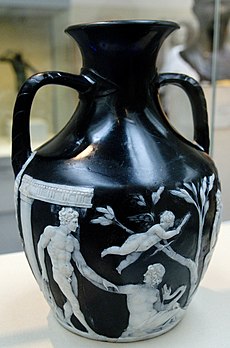| Portland Vase | |
|---|---|
 | |
 | |
| Material | Cameo glass |
| Size | Height 24 cm (9.4 in), Diameter 17.7 cm (7.0 in) |
| Created | 5–25 AD |
| Present location | British Museum, London |
| Registration | GR 1945.9-27.1 (Gems 4036) |
The Portland Vase is a Roman cameo glass vase, which is dated between AD 1 and AD 25, though low BC dates have some scholarly support.[1] It is the best known piece of Roman cameo glass and has served as an inspiration to many glass and porcelain makers from about the beginning of the 18th century onwards. It was first recorded in Rome in 1600–1601, and since 1810 has been in the British Museum in London. The museum held it on loan from the dukes of Portland until 1945, and bought it from them that year (GR 1945,0927.1). It is normally on display in Room 70.
The vase measures about 25 centimetres (9.8 in) high and 18 cm (7.1 in) in diameter. It is made of violet-blue glass, and surrounded with a single continuous white glass cameo making two distinct scenes, depicting seven human figures, plus a large snake, and two bearded and horned heads below the handles, marking the break between the scenes.
The bottom of the vase was a cameo glass disc, also in blue and white, showing a head, presumed to be of Paris or Priam based on the Phrygian cap it wears. This roundel[citation needed] clearly does not belong to the vase and has been displayed separately since 1845. It may have been added in antiquity or later, or is the result of a conversion from an original amphora form (paralleled by a similar blue-glass cameo vessel from Pompeii). It was attached to the bottom from at least 1826.
- ^ The British Museum dates it between AD 1 and AD 25 – collection database ("5–25 AD" per the Highlights section, and Williams in 2009); a date some time between 30 BC and 20 BC was suggested in 1990, following research by William Gudenrath, Kenneth Painter and David Whitehouse, director of the Corning Museum of Glass, Journal of Glass Studies, Vol 32 1990.